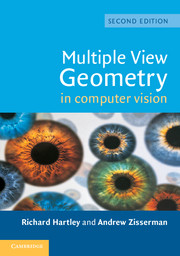Book contents
- Frontmatter
- Contents
- Foreword
- Preface
- 1 Introduction – a Tour of Multiple View Geometry
- PART 0 The Background: Projective Geometry, Transformations and Estimation
- PART I Camera Geometry and Single View Geometry
- PART II Two-View Geometry
- 9 Epipolar Geometry and the Fundamental Matrix
- 10 3D Reconstruction of Cameras and Structure
- 11 Computation of the Fundamental Matrix F
- 12 Structure Computation
- 13 Scene planes and homographies
- 14 Affine Epipolar Geometry
- PART III Three-View Geometry
- PART IV N-View Geometry
- PART V Appendices
- Bibliography
- Index
9 - Epipolar Geometry and the Fundamental Matrix
Published online by Cambridge University Press: 25 January 2011
- Frontmatter
- Contents
- Foreword
- Preface
- 1 Introduction – a Tour of Multiple View Geometry
- PART 0 The Background: Projective Geometry, Transformations and Estimation
- PART I Camera Geometry and Single View Geometry
- PART II Two-View Geometry
- 9 Epipolar Geometry and the Fundamental Matrix
- 10 3D Reconstruction of Cameras and Structure
- 11 Computation of the Fundamental Matrix F
- 12 Structure Computation
- 13 Scene planes and homographies
- 14 Affine Epipolar Geometry
- PART III Three-View Geometry
- PART IV N-View Geometry
- PART V Appendices
- Bibliography
- Index
Summary
The epipolar geometry is the intrinsic projective geometry between two views. It is independent of scene structure, and only depends on the cameras' internal parameters and relative pose.
The fundamental matrix F encapsulates this intrinsic geometry. It is a 3 × 3 matrix of rank 2. If a point in 3-space x′ is imaged as x in the first view, and x′ in the second, then the image points satisfy the relation x′TFx = 0.
We will first describe epipolar geometry, and derive the fundamental matrix. The properties of the fundamental matrix are then elucidated, both for general motion of the camera between the views, and for several commonly occurring special motions. It is next shown that the cameras can be retrieved from F up to a projective transformation of 3-space. This result is the basis for the projective reconstruction theorem given in chapter 10. Finally, if the camera internal calibration is known, it is shown that the Euclidean motion of the cameras between views may be computed from the fundamental matrix up to a finite number of ambiguities.
The fundamental matrix is independent of scene structure. However, it can be computed from correspondences of imaged scene points alone, without requiring knowledge of the cameras' internal parameters or relative pose. This computation is described in chapter 11.
Epipolar geometry
The epipolar geometry between two views is essentially the geometry of the intersection of the image planes with the pencil of planes having the baseline as axis (the baseline is the line joining the camera centres).
- Type
- Chapter
- Information
- Multiple View Geometry in Computer Vision , pp. 239 - 261Publisher: Cambridge University PressPrint publication year: 2004
- 11
- Cited by

